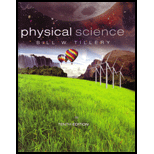
Concept explainers
According to the definition of mechanical work, pushing on a rock accomplishes no work unless there is _
a. movement.
b. a net force.
c. an opposing force.
d. movement in the same direction as the direction of the force.
The correct option to complete the statement, “According to the definition of mechanical work, pushing on a rock accomplishes no work unless there is”, from the following options,
movement.
a net force.
an opposing force.
movement in the same direction as the direction of the force.
Answer to Problem 1AC
Solution:
Option (d) is correct.
Explanation of Solution
Introduction:
According to the concept of mechanical work, net work is done on an object if it experiences a net force that brings a displacement in the object.
Explanation:
Reason for the correct options:
When direction of applied force and direction of movement are same then only maximum work will be done.
Hence, option (d) is correct.
Reason for the incorrect options:
Option (a) is incorrect because the movement can be perpendicular to the direction of the force. Now if the angle between the force and the displacement is 90 degrees, then the work done comes out to be zero. Hence, it is a wrong option.
Option (b) is incorrect because the presence of net force does not give any information about the displacement of object which is necessary for any work to be done.
Option (c) is incorrect because even if an opposing force is present, there is no movement or there is a movement but at a right angle. So, opposing force doesn’t imply that work is always done. Hence, it is a wrong option.
Hence, options (a), (b) and (c) are incorrect.
Conclusion:
A force will do work on an object only if it has a component in the direction parallel to the motion of the object. Thus, a push on a rock will accomplish work only when the movement of the rock is in the same direction as the direction of the force.
Want to see more full solutions like this?
Chapter 3 Solutions
Physical Science
- Pls help ASAParrow_forward12. A motorboat traveling 6 m/s, West encounters a water current travelling 3.5 m/s, South. a) Draw a vector diagram showing the resultant velocity, then determine the resultant velocity of the motorboat. b) If the width of the river is 112 m wide, then how much time does it take for the boat to travel shore to shore? c) What distance downstream does the boat reach the opposite shore?arrow_forwardLake Erie contains roughly 4.00⋅10114.00⋅1011 m3 of water. Assume the density of this water is 1000. kg/m3 and the specific heat of water is 4186 J/kg˚C. It takes 2.31x10^19 J of energy to raise the temperature of that volume of water from 12.0 °C to 25.8 ˚C. An electric power plant can produce about 1110 MW. How many years would it take to supply this amount of energy by using the 1110 MW from an electric power plant?arrow_forward
- Pls help ASAParrow_forwardPls help ASAParrow_forwardm m $2° 15. A truck is stopped at a red light. Once the light turns green, the truck accelerates forward at 1.75- that same instant, a car moving with a constant speed of 50 — passes the truck. a) How many seconds will it take for the truck to catch up to the car? S b) How many metres will the truck travel before it catches up to the car? Atarrow_forward
- Pls help ASAParrow_forwardI need help adding more information to my study guide. This is subject is physics My topic : Emission Spectrum Target Material I need information on this topic but make it as study guide form and make 5 questions and include the answers.arrow_forwardAn electron and a proton are each moving at 755 km/s in perpendicular paths as shown in (Figure 1). Find the magnitude of the total magnetic force that the electron exerts on the proton. Find the magnitude of the total electrical force that the electron exerts on the proton.arrow_forward
 University Physics Volume 1PhysicsISBN:9781938168277Author:William Moebs, Samuel J. Ling, Jeff SannyPublisher:OpenStax - Rice University
University Physics Volume 1PhysicsISBN:9781938168277Author:William Moebs, Samuel J. Ling, Jeff SannyPublisher:OpenStax - Rice University Principles of Physics: A Calculus-Based TextPhysicsISBN:9781133104261Author:Raymond A. Serway, John W. JewettPublisher:Cengage Learning
Principles of Physics: A Calculus-Based TextPhysicsISBN:9781133104261Author:Raymond A. Serway, John W. JewettPublisher:Cengage Learning College PhysicsPhysicsISBN:9781305952300Author:Raymond A. Serway, Chris VuillePublisher:Cengage Learning
College PhysicsPhysicsISBN:9781305952300Author:Raymond A. Serway, Chris VuillePublisher:Cengage Learning Glencoe Physics: Principles and Problems, Student...PhysicsISBN:9780078807213Author:Paul W. ZitzewitzPublisher:Glencoe/McGraw-Hill
Glencoe Physics: Principles and Problems, Student...PhysicsISBN:9780078807213Author:Paul W. ZitzewitzPublisher:Glencoe/McGraw-Hill An Introduction to Physical SciencePhysicsISBN:9781305079137Author:James Shipman, Jerry D. Wilson, Charles A. Higgins, Omar TorresPublisher:Cengage Learning
An Introduction to Physical SciencePhysicsISBN:9781305079137Author:James Shipman, Jerry D. Wilson, Charles A. Higgins, Omar TorresPublisher:Cengage Learning Physics for Scientists and Engineers with Modern ...PhysicsISBN:9781337553292Author:Raymond A. Serway, John W. JewettPublisher:Cengage Learning
Physics for Scientists and Engineers with Modern ...PhysicsISBN:9781337553292Author:Raymond A. Serway, John W. JewettPublisher:Cengage Learning





